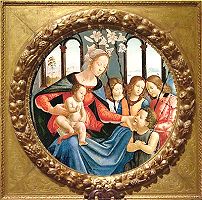 click to enlarge |
Madonna And Child With St. Johm And Three Angels
SN 20 Oil on a Round Panel (Tondo) About 1490 From: "The Pages"
|
ARTIST:
Domenico Ghirlandaio was a Florentine painter, mosaicist and possibly a goldsmith from a prosperous family of artisans and businessmen. He was a pupil of Baldovinetti; in his early works influenced by Verrochio, Baldovinetti and Pallaiuolo. One of his earliest independent works is a fresco in S. Andrea a Brozzi, depicting SS Barbara, Jerome and Anthony. In Rome he painted eight lunetta, the busts of the Church Fathers and Classical Philosophers; a commission from the Vatican. In Florence he painted the Sassetti Chapel frescoes among others. His monumental and last significant fresco cycle is of scenes from “The Life of the Virgin” and “Life of St. John the Baptist”, which Giovanni Tornabuoni commissioned for the family chapel in Santa Maria Novella, Florence. While fully engaged as a fresco painter Ghirlandaio and his workshop painted a remarkable number of panels, thus testifying the secure commercial success of his business. Domenico had characteristic skill in synthesizing many sources of inspiration including classical sculpture, the monumental frescoes of the Sistine Chapel and Flemish painting. Several panels survive from the 1480s and 1490s. He was drawn to Leonardo da Vinci’s less mature composition style which was more in harmony with his own style and temperament. Ghirlandaio had a large workshop where artists were trained and assisted, including Bastiano Mainardi, his brother-in-law among others. Thus the obvious variations in quality in some works associated with his name has led to endless conjecture over attributions, as the above panel. While Mainardi’s independent style is somewhat clearer, owing to the survival of paintings by him in San Agostino, San Gimigniano, detail of his participation in Ghirlandaio’s workshops remains obscure.
SUBJECT:
In the painting the artist creates a certain model. The picture is a worldly scene; however, this is a heavenly occurrence in the world. The Madonna is a tender, loving mother reaching out to St. John, who is looking at the redeemer. The Child is blessing him – a sacra conversazione. The scene is contemplative and inspires the viewer to prayer. It is highlighted by three angels holding lilies, symbolic of purity and innocence.
PAINTING:
The round panel, called a tondo, has a special meaning. In Italy in the late quatrocento and early ciquecento a circle was understood to be the poetic analogy to eternity, heavenly harmony and perfection. This circular pattern is also repeated in the configuration of the future: the Madonna’s face through her right arm to her child, then following the folds of her blue dress to St. John, to the inward inclination of the had of the far angel leading back to the Madonna. The Madonna’s face is strikingly serene and beautiful, ethereal, - the kind of remote idealized beauty popular in the Renaissance.
Through the symmetrical oval windows one can see water and the outlines of a city, identified as Venice, on the right. The left scene is less conclusive and open to interpretation. A distant person riding a donkey with a figure behind it, suggests the possibility of Jerusalem or Bethlehem and the Flight to Egypt. This painting was very popular at the time. Several variants are attributed to Bastiano Mainardi. They are at the Musee de Louvre, Paris; Capedimonte, Naples; National Museum, Washington DC; Sackville Gallery, London and others.
HISTORIC CONTEXT:
The evolution in painterly depiction of the Madonna and Child parallel the humanistic development in the Renaissance: developing from flat, decorative iconic renderings to realistic portrayals of people with plausible feelings. The Renaissance introduced man in this own environment in three dimensions.